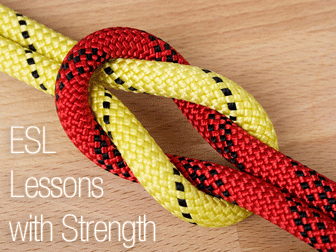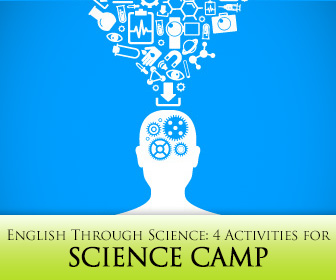Extreme Structures: ESL Lessons with Strength


Students love working with their hands, building things, blowing things up, making a mess, and all the good times that go with it. They can be a lot of fun for teachers as well. Just remember, the point is still to teach English, not science. Pair each lesson with some key phrases and vocabulary and/or make sure the students are only using English when they are working on the project. Beyond that, have a blast! Here are five great science camp activities for you to try out.
Note: The language suggestions with each camp are just that: suggestions. Depending on the class level, the teacher will have to determine what, if any, new phrases they want to introduce. For high level classes there may not be any new language for them. In this case, try giving them written instructions about the project and have one student read them aloud to the rest of their team. This will practice listening skills, which is often the weakest area for ESL students.

What you need: Eggs, string, glue, tape, paper, cardboard, packing peanuts, anything else they might need/want to protect their egg, balloons or bags
Language suggestions: Conditionals (if you protect your egg/create a parachute/ etc.), height words, speed words, accelerations etc.
How it works: A short lesson on the phrases and terminology. Explain the goal to the students and show them the location where the eggs will be dropped so they can really understand what they are trying to achieve. For advanced classes show them some of the science behind it. Mass, acceleration, etc. Explain the different theories behind having your egg survive the drop and show them the materials they have to work with. Have the groups make a plan for their egg drop device. Give them a set time limit to build their egg device (30-60 minutes). Drop the devices from the pre-determined location (sometimes this may have to wait a full day for glue to dry on some of the devices – decide ahead of time if this will be allowed). The egg that survives the most drops is the winner.
What you need: Tape, glue, string, spaghetti, some kind of weight that can be applied in increments, a gap to span between two desks is usually best
Language suggestions: talk about comparatives and superlatives (stronger/strongest), bridge, build/construct, thick, thin, distance/measurements
How it works: Depending on the class level, have a short lesson on the vocabulary and phrases. Hand out the instructions and specifications for the bridge and have the students review them in their groups. Have them sketch out a plan for their bridge. Emphasise that they are supposed to use only English in this part of the lesson. Once they have a plan, hand out the materials (each group should get the same amount of each material measured in advance by the teacher). This task must be completed within a set time, so all groups need to start at once. Usually give the students 15-30 minutes, depending on the age group, to complete building their bridge. Once all bridges are complete the teacher will test them by placing weights in the middle of the bridge until it breaks. Whichever bridge holds the most weight wins. As an extension activity, students can write comparative and superlative sentences about the bridges.
Notes: Spaghetti creates less plastic waste than the traditional straws. Another option is toothpicks and marshmallows.
What you need: Tub of water, various objects that float or sink, sheets of paper, glue, tape, staples, small weights (large coins work great)
Language suggestions: Predictions (eg. I think that…) and conclusions; past tense (eg. The boat sank.); future tense (eg. The boat will float.)
How it works: At the beginning of class, give each group a sheet of paper and instruct them to create a paper boat in a set amount of time. Don’t give any further explanation. After the time is up float each boat in the tub of water. Slowly add weight to the boat until it sinks (note: be sure the weight is distributed evenly throughout the boat or it will sink prematurely). Once this is finished, have a short discussion about what makes things sink or float. Lay out a variety of objects and have each group write predictive sentences about whether they will sink or float. Test each in the tub. Groups get one point for each prediction they get correct. Once this is complete, have a further discussion about why some things float and others sink. Finally, have each group make a second paper boat. You may want to give them a longer time and allow them to use more materials for this second attempt. Have the students predict how much weight each boat will take before it sinks. Repeat the testing process with the boats. The boat that takes the most weight before it sinks wins, earning a set amount of points. Groups get a point for each prediction they get correct. Declare a winner based on points.
What you need: Large jars or cans, large Ziploc bags (two for each group), cream or half-and-half, crushed ice or snow, rock salt (not table salt), vanilla, sugar, gloves
Language suggestions: Cooking measurement terminology, comparatives (hotter/colder)
How it works: Go through the language with the class. Explain that today we will be making ice cream without using a freezer!! Tell the students what materials they will have to work with and have them speculate about how/why the process might work. Hand out a set of instructions to each pair or group (there is a lot of shaking in this activity so the students need to be in pairs at the very least). Depending on the level, you can review them with the students or simply leave them to their own devices. For listening practice, have one student from each group stand well away from the workstation and read the instructions aloud to the others. They must listen carefully and follow the verbal directions to make their ice cream.
Put the ice in a jar or can with 5-8 tablespoons of rock salt, seal it and shake for five to eight minutes. Then mix half a cup of half & half, one tablespoon of sugar, and half a tablespoon of vanilla in one of the large Ziploc bags. Seal this with as little air inside as possible and then double bag it inside the other Ziploc (one bag is not enough!). Place these two bags in with the salt and ice and then shake for another 15 minutes or until the ingredients have taken on the proper consistency for ice cream. Remove the bags from the ice mixture, rinse them with fresh water, open them, and enjoy!
For extra language practice have the students describe the process using comparatives (ie. adding more salt made the jar colder).

Many of them are best for younger students, but at the end of the day any experiment that allows students to practice using English to complete a task or discuss an outcome is suitable. When planning a science camp, be sure you take the time to determine which language points will be part of each activity. Going in without a solid plan will leave you scrambling for some sort of language outcome. Finally, test the activities before you take them to class. Ingredients and results can vary region to region. Beyond that, let’s face it: science is fun for us, too. Have a blast!